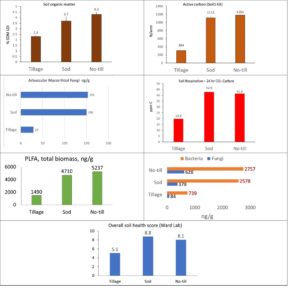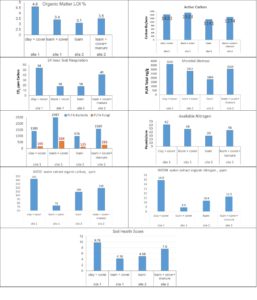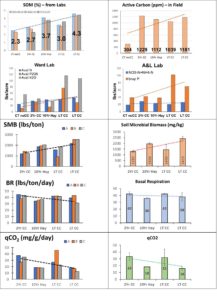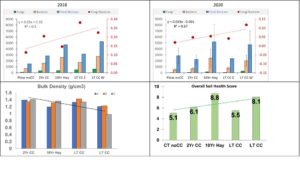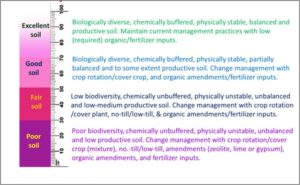Final report for ONC18-047
Project Information
Most Midwest grain (corn and soybean) farmers value the importance and role of soil health for sustainable agriculture, however lack the tools and knowledge to test and interpret indicators of soil health. Currently available commercial soil health test reports seldom provide practical recommendations for improving and/or maintaining on-farm soil health. Thus, farmers are left to their own intuition for interpretation and adoption of good soil health practices. We formed partnerships with soil scientists and farmers to conduct on-farm monitoring of soil health, identify consistent and reliable soil health indicators, and develop practical management recommendations matrix based on soil health test results.
- Monitor relevant soil health parameters, agronomic factors and yields at 8 research sites
- Develop a list of preferred indicators for rapid to comprehensive soil health testing that is most suitable for the region
- Develop interpretations and practical recommendations based on soil health testing and long-term research
- Conduct outreach with field days, agronomy reports, extension factsheets, and conference presentations
Cooperators
- (Researcher)
- (Educator)
- (Researcher)
- (Researcher)
Research
Soil health sampling:
Soil health samples were collected from participating farms. Soil samples represented grain crop management systems common in Ohio and the Midwest: tillage, no-tillage, alfalfa hay, organic grain crops, cover crops, and manure. Grain crops grown include: corn, soybean, wheat, oats, alfalfa. Infield measurements were taken: soil temperature, soil moisture, infiltration, and penetrometer. Duplicate soil samples were collected for soil health laboratory analysis by Ward Labs, A & L labs, and Ohio State South Centers lab. The research involved the following three main study locations:
Study 1:
- No-till grass sod (Festuca spp),
- Tillage with less than 30% crop residue on corn/soybean crop production,
- No-till corn/soybean crop production with multi-species cover crop.
Study 2:
- clay soil with cover crops
- loam soil with cover crops
- loam soil no cover
- loam soil with cover crops and manure application
Study 3:
- CT noCC: Conventionally tilled – no Cover Crops
- 2Yr CC: Recently transitioned to Cover Crops
- 10Yr Hay: Under hay for 10 years
- LT CC: 20 to 30 years of no-till and cover crops
- LT CC: 30 to 40 years of no-till and cover crops
Soil health analysis:
The soil health analysis involved field assessments of soil properties as well as laboratory assessment. A detailed list of soil properties and laboratory tests is given in Table 1.
Table 1: Summary of soil health testing
|
Test name |
Test details |
|
IN-FIELD ASSESSMENT |
|
|
Field assessment |
· Soil penetration resistance · Infiltration rate · Soil moisture · Soil temperature · Slake test · Soil1 Field test kit for active carbon |
|
WARD LAB |
|
|
PLFA |
· Total bacteria (gram +, gram -), total Fungí (arbuscular Mycorrhizae, Saprophytes), Protozoa, undifferentiated microorganisms. · Total bacteria (gram+, gram -) · total fungi (arbuscular mycorrhizae, saprophytes) · protozoa · undifferentiated microorganisms |
|
Haney Test |
· pH, excess lime rating, soluble salts · organic matter (LOI) · Soil Respiration · Total Organic C, Total N, total Organic N (WEOC/N) · Nitrate-N, Ammonium-N, Inorganic N, Total P, inorganic P, Organic P, K, Ca, Mg |
|
Active Carbon |
· POX-C, (ppm) using potassium permanganate |
|
OSU LAB |
|
|
Custom soil health test |
· Bulk density · Total and water-filled porosity · Moisture content · Soil pH and soluble salts (ECe) · Total organic C and N · Total P · Active C (POX-C) · Particulate organic matter (POM) · Total microbial biomass C and N (microwave method) · Soil (basal) respiration · Specific maintenance respiration (qCO2) · Potentially mineralizable C, N and P |
|
A&L Lab |
|
|
S1AB |
· Organic Matter, Available Phosphorus, Exchangeable Potassium, Magnesium, Calcium, Soil pH, Buffer pH, Cation Exchange Capacity, Percent Base Saturation of Cation Elements · Strong Bray & Sodium Bicarbonate Phosphorus · Ammonium and Nitrate |
Objective 1: Monitor relevant soil health parameters, agronomic factors and yields at 8 research sites
Graphical summaries of representative results from each study are presented below. Overall, measurements correlated well among the various testing methods as well as laboratories. Furthermore, the biological soil health indicators clearly showed the differences and contrasts among various management systems and soils. For example, the no-till sod and the no-till crop production with cover crops had similar soil health measurements, which were significantly higher compared to tillage crop production. Furthermore, the study-3 showed a progressive improvement in soil health indicators as we go from conventional to short to long-term soil health practices.
Study 1:
- No-till grass sod (Festuca spp),
- Tillage with less than 30% crop residue on corn/soybean crop production,
- No-till corn/soybean crop production with multi-species cover crop.
Study 2:
- clay soil with cover crops
- loam soil with cover crops
- loam soil no cover
- loam soil with cover crops and manure application
Study 3:
- CT noCC: Conventionally tilled – no Cover Crops
- 2Yr CC: Recently transitioned to Cover Crops
- 10Yr Hay: Under hay for 10 years
- LT CC: 20 to 30 years of no-till and cover crops
- LT CC: 30 to 40 years of no-till and cover crops
Objective-2: Develop a list of preferred indicators for rapid to comprehensive soil health testing that is most suitable for the region.
Considering the delays in obtaining results and the large dataset that was generated from this project, the data analysis and synthesis is still underway within our team. Furthermore, we have formed collaboration with the OSU soil fertility laboratory to unify recommendations across the university and integrate soil health testing with the soil fertility testing protocols. The data collected from this project will be shared with the larger database that aims to aggregate soil health testing data across Ohio for developing soil health test recommendations. Based on this project’s findings and our initial communications with the OSU soil health team, a preliminary list of recommended soil health indicators for field- and laboratory-based soil health assessment is given in Table 2.
Table 2. Preliminary list of recommended soil health indicators
|
Field Assessment |
Lab assessment |
|
Soil penetration resistance Infiltration Soil moisture and temperature Slake test Soil1 Field test kit Solvita test kit |
Bulk density Aggregate stability Soil organic matter Active carbon or Pox-C Particulate organic matter Soil pH, EC Extractable nutrients (Available N, P, K) Soil respiration Soil microbial biomass Soil protein Haney Test PLFA Test |
Objective 3: Develop interpretations and practical recommendations based on soil health testing and long-term research
A preliminary interpretation and recommendations matrix based on the Active carbon test was developed as part of the OSU Soil1 field test kit (Figure 2). The interpretation and practical recommendation matrix is anticipated to be an outcome through the collaborative work with the OSU Soil fertility lab.
Objective 4: Conduct outreach with field days, agronomy reports, extension factsheets, and conference presentations
A detailed report is included in the education and outreach section.
Educational & Outreach Activities
Participation Summary:
Various outreach activities and events were conducted during the project period. Soil health measurements were presented at winter Agronomy Schools, workshops, and field days. Outreach articles in the www.CORN.osu.edu newsletter occurred on April 9, April 16, and April 30, 2018. This reached over 2,000 farmers and ag professionals in Ohio and beyond. The farm science review soil health demonstrations reached over 200 attendees. The website – www.soilhealth.osu.edu has also been accessed by over 1000 users with more than 3000 page views during the project period. A detailed list of education and outreach activities and educational material is included below.
Youth Education:
- 3-10-2018 Ohio State University Extension Annual 4-H Conference, Columbus, OH: Soil Health demonstration given to 4-H adult advisors. This activity can be repeated at local club meetings across the state.
- 5-11-2018 Kenwood Elementary School, Bowling Green, OH annual nature day. Soil Health demonstration given to Grades 3-5. Approximately 300 attended.
- 5-15-2018 Wood County Ag Day, Bowling Green, OH. All 3rd grade classes in the Bowling Green school district attended a soil health demonstration. Approximately 250 attended.
- 5-10-2019 Kenwood Elementary School, Bowling Green, OH annual nature day. Soil Health demonstration given to Grades 3-5. Approximately 300 attended.
- 5-12-2019 Wood County Ag Day, Bowling Green, OH. All 3rd grade classes in the Bowling Green school district attended a soil health demonstration. Approximately 250 attended.
Workshops/ Field Days/Webinars :
- At the 2018 and 2019 Ohio State University Farm Science Review near London, Ohio, the Soil Health team was featured with displays and interaction with attendees. 5,000 gummy worm packets with the website were distributed.
- The annual Conservation Tillage Conference in Ada, Ohio featured soil health presentations during the 2018, 2019, and 2020 event. Each year over 800 attended.
- 1-21-2021 Webinar – What Can Soil Health Tests Tell You? (Culman and Shedekar) – 190 attended (https://agcrops.osu.edu/events/webinar-recordings/dirt-soil-health-investing-below-surface-0)
- 4-15-2021 Online Invited talk – University of Minnesota soil health and water quality team (Shedekar). 12 attended.
- Table 3 below summarizes local events which featured soil health presentations or demonstrations conducted by the OSU soil health team. Attendance varied from 25 to 300.
Table 3: Summary of outreach events conducted by the project team and collaborators
|
Event date and location |
No. of participants |
|
3-13-18 Wapakoneta, OH |
25 |
|
3-27-18 Tiffin, OH |
61 |
|
7-9-18 Pandora, OH |
23 |
|
7-10-18 Ashtabula, OH |
18 |
|
7-16-18 Toledo, OH |
78 |
|
7-24-18 Vincennes, IN |
124 |
|
8-8-18 Mentor, OH |
26 |
|
8-16-19 Piketon, OH |
34 |
|
8-22-18 Bucyrus, OH |
36 |
|
8-29-18 Wooster, OH |
82 |
|
1-14-19 New Bremen, OH |
35 |
|
2-8-19 Ottawa, OH |
79 |
|
2-27-19 Wapakoneta, OH |
35 |
|
2-28-19 Gibsonburg, OH |
64 |
|
3-12-19 Paulding, OH |
42 |
|
3-15-19 Archbold, OH |
45 |
|
6-20-19 Hoytville, OH |
112 |
|
7-23-19 Fayette County, OH |
26 |
|
8-29-19 Bucyrus, OH |
185 |
|
8-27-19 Wooster, OH |
55 |
|
1.21.21 Webinar |
190 |
|
4.15.2021 Online Invited talk |
12 |
Publications and products:
Conferences:
- 2020 Sundermeier and Shedekar. Soil Biological Response to BMP – invited talk at Conservation Tillage Conference, Ada, OH (March 4)
- 2020 Shedekar and Sundermeier. Decision tools for climate-smart agriculture – invited talk, Building Agricultural Resilience to a Changing Climate Workshop, 2020 OEFFA Annual Conference, Dayton Ohio (Feb. 13)
- 2019 Cover Crops and Water Budget – Invited talk at the Conservation Tillage and Technology Conference, Ada, Ohio (March 5-6)
- 2019 Shedekar, V.S., Islam, K.R., Raut, Y.R, Fausey, N.R., Watts, D., Gonzalez, J., Dick, W., Van Toai, T., Flanagan, D. 2019. Effect of Cover Crops and Crop Rotation on Physical Properties of Soils Amended with Flue Gas Desulfurization Gypsum. Proc. ASA, CSSA and SSSA International Annual Meetings, Nov 10-13, 2019, San Antonio, TX.
Extension Publications
- White Papers : https://soilhealth.osu.edu/resources/publications
- Soil Aggregate Stability, Soil Infiltration, Avoiding Soil Compaction, Slake Test, Soil Food Web, Solvita Test for Soil Respiration, Haney Test for Soil Health, PLFA Test for Soil Biological Quality, Effect of Soil Conservation on Soil Health Indicators.
Journal Articles :
- Sundermeier, A., Shedekar, V.S. 2019. Soil Biological Response to Best Management Practices. Journal of the NACAA. 12(2). https://www.nacaa.com/journal/index.php?jid=1004
Popular Press
- Sundermeier, A., Shedekar, V.S. 2019. Soil Biological Response to Best Management Practices. 2019 eFields Report. Ohio State Digital Ag Program (www.digitalag.osu.edu/efields)
- Sundermeier A.P., and Shedekar, V.S. 2019. Soil food web. C.O.R.N. Newsletter (2019-11), 4/30/2019 (www.agcrops.osu.edu/newsletter/corn-newsletter)
- Sundermeier A.P., and Shedekar, V.S. 2019. The PLFA Soil Health Test. C.O.R.N. Newsletter (2019-09), 4/16/2019 (www.agcrops.osu.edu)
- Sundermeier A.P., and Shedekar, V.S. 2019. Solvita® CO2 Respiration Soil Health Test. C.O.R.N. Newsletter (2019-08), 4/9/2019 (agcrops.osu.edu)
Learning Outcomes
Project Outcomes
- OSU Project team was instrumental in commercializing an Active Carbon assessment field kit (Soil1)
- A series of whitepapers - each describing key physical, chemical, and biological components of soil health were developed and published (https://soilhealth.osu.edu/resources/publications)
- The project resulted in a comprehensive dataset of soil health assessment that includes:
- A range of soil types, management practices, and soil health practice history
- Comparison of three different laboratories - demonstrating the level of agreement and disagreement between labs for some common soil health indicators
- One peer reviewed publication (Sundermeier, A., Shedekar, V.S. 2019. Soil Biological Response to Best Management Practices. Journal of the NACAA. 12(2). https://www.nacaa.com/journal/index.php?jid=1004
